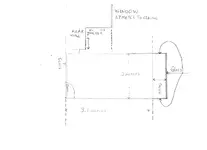W
wannaknow
New member
I want to check with the Guru's here to see if I'm on the right track treating a voice-over booth. The space is on the second floor of a commercial building. It's 2 meters wide, 4.1 meters long, 2.7 metres high. The 2 meter wall with the door is glass; the rear wall has a weird step up that's 1 meter high and 1 meter deep with a 3 sided window 1.7 meters high. I plan to put 2, 1200mm x 2400mm x 100mm panels on each long wall, and 2, 1000mm x 1000mm x 100mm movable panels in the window area, and suspend 1, 1200mm x 2400mm x 50mm panel from the ceiling, The glass wall and door will have either 50mm or 100mm thick panels. The panels will be made of with a product called Acoustisorb 2. I'll also make a panel to go behind the mic. Hope you can make sense of my crude diagram:
 My question is, does this make acoustic sense? "Quality voice-over is the primary consideration" There may be a ventilation issue, but that can be addressed separately. Any guidance will be greatly appreciated.
My question is, does this make acoustic sense? "Quality voice-over is the primary consideration" There may be a ventilation issue, but that can be addressed separately. Any guidance will be greatly appreciated.
 My question is, does this make acoustic sense? "Quality voice-over is the primary consideration" There may be a ventilation issue, but that can be addressed separately. Any guidance will be greatly appreciated.
My question is, does this make acoustic sense? "Quality voice-over is the primary consideration" There may be a ventilation issue, but that can be addressed separately. Any guidance will be greatly appreciated.Attachments
Last edited:


 I know of someone that does professional voice-over work from their home. (I haven't seen their space) I'm pretty sure they don't have near the amount of treatment I'm proposing. My thinking is; I don't have to be overly concerned with low frequencies below 150hz / 200hz because there will only be spoken words. There will be an air gap behind the panels. There will be very little bare wall exposed.
I know of someone that does professional voice-over work from their home. (I haven't seen their space) I'm pretty sure they don't have near the amount of treatment I'm proposing. My thinking is; I don't have to be overly concerned with low frequencies below 150hz / 200hz because there will only be spoken words. There will be an air gap behind the panels. There will be very little bare wall exposed.